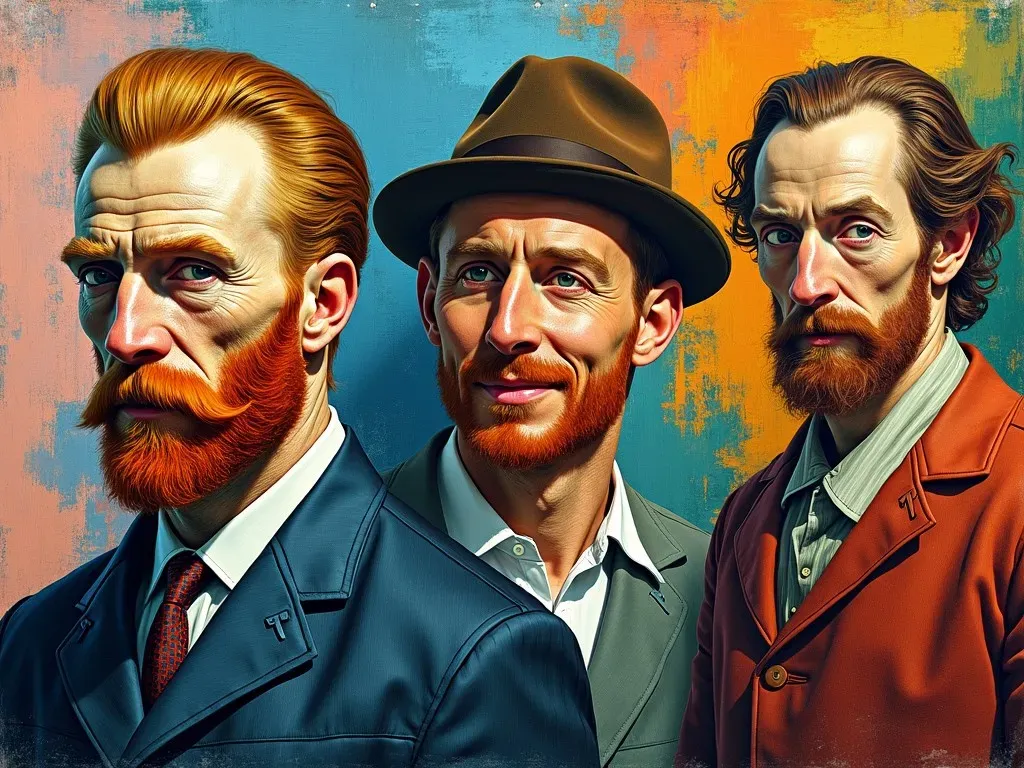In the world of art, male painters have historically played pivotal roles in shaping the artistic landscape. From the strokes of the Renaissance to the bold expressions of modernism, these male artists have made indelible marks on society.
Renowned Male Painters Through History
Across centuries, numerous male painters have emerged, each contributing to the art world with unique styles and perspectives. Here’s a snapshot of some of the most eminent male painters:
| Name | Nationality | Period | Notable Works |
|---|---|---|---|
| Leonardo da Vinci | Italian | Renaissance | Mona Lisa, The Last Supper |
| Vincent van Gogh | Dutch | Post-Impressionism | Starry Night, Sunflowers |
| Pablo Picasso | Spanish | Cubism | Guernica, The Weeping Woman |
| claude monet | French | Impressionism | Water Lilies, Impression, Sunrise |
| Jackson Pollock | American | Abstract Expressionism | No. 5, 1948 |
| Michelangelo | Italian | Renaissance | David, The Creation of Adam |
These artists not only revolutionized Techniques but also influenced culture and society in profound ways.
The Evolution of Male Artists
Male painters have undergone significant transformations in their artistic journey. Traditionally, many were trained through rigorous apprenticeships, learning the intricacies of painting from established masters. As art movements evolved—from the Baroque to Romanticism and beyond—so too did the themes and styles.
- Classical Period (500 BC – 400 AD): Paintings focused on mythological themes, humanism, and realistic representation.
- Renaissance (1300 – 1600): Marked by a return to classical ideals, male painters like Da Vinci and Michelangelo emphasized perspective and anatomical accuracy.
- Romanticism (late 18th – mid-19th century): Focused on emotion and nature, promoting individualism. Artists like Delacroix flourished during this period.
- Modernism (late 19th – mid-20th century): Led to the emergence of avant-garde movements, including Impressionism and Cubism. Artists such as Monet and Picasso challenged traditional representations.
Table: Notable Art Movements and Their Characteristics
| Movement | Time Period | Key Features |
|---|---|---|
| Baroque | 1600 – 1750 | Dramatic lighting, intense emotions |
| Romanticism | 1800 – 1850 | Individual perspective, nature themes |
| Impressionism | 1860 – 1900 | Light effects, everyday subjects |
| Cubism | 1907 – 1917 | Multiple perspectives, geometric shapes |
| Abstract Expressionism | 1940s – 1950s | Spontaneity, non-representational forms |
Reference Video
Influential Male Painters of the 20th Century
The 20th century brought forth a significant shift in artistic expression, with male painters at the forefront of various movements.
1. Jackson Pollock
Pollock revolutionized the art world with his drip painting technique, epitomizing Abstract Expressionism. His work was characterized by chaotic energy and a loose painterly style.
2. Andy Warhol
As a leading figure of the Pop Art movement, Andy Warhol challenged the boundaries between high art and popular culture. His works often featured commercial products and celebrity portraits, such as the iconic Campbell’s Soup Cans.
3. Jean-Michel Basquiat
Basquiat emerged from the New York City graffiti scene to become a prominent Neo-Expressionist artist, addressing themes of race, identity, and socioeconomic status. His works are known for their raw energy and vibrant colors.
Spotlight on Contemporary Male Painters
Today, male painters continue to innovate and address current societal issues through their work. Notable figures include:
-
Kehinde Wiley: Famous for his candid portrayals of African American men in traditional settings, Wiley’s work takes classical portraiture and infuses it with contemporary themes.
-
Yayoi Kusama: Though a pioneer female artist, her collaborations with male painters such as Lucas Samaras highlight how gender dynamics can shift in collaborative artistic expressions.
-
Banksy: This anonymous street artist has become a global phenomenon, utilizing graffiti to make poignant social commentary.
The Artistic Impact of Male Painters
The influence of male painters extends beyond the canvas. They have shaped cultural movements through their art, impact on fashion, and contributions to political discourse. Their work often reflects societal changes, challenging viewers to confront uncomfortable truths.
FAQ
Who are some famous male painters?
Some famous male painters include Leonardo da Vinci, Vincent van Gogh, Pablo Picasso, Michelangelo, and Jackson Pollock.
What defines a male painter’s style?
Each male painter has a unique style defined by their cultural background, time period, and personal experiences. For instance, Impressionist painters focused on light and color, while Cubism introduced abstract representations.
How have male painters influenced contemporary art?
Male painters have significantly influenced contemporary art by pushing boundaries, challenging societal norms, and experimenting with new techniques and mediums.
Where can I find a comprehensive list of male painters?
A comprehensive list can be found at Ranker: Famous Male Painters and The Famous People: Male Artists & Painters.
Are there male painters who address social issues in their work?
Yes, many male painters today address social issues in their work, such as Kehinde Wiley, whose portraits celebrate African American culture and history.
With a rich history and ongoing influence, male painters continue to captivate and inspire art lovers around the world. Their colorful legacies and innovative techniques remind us of the power art holds in reflecting and shaping society.
